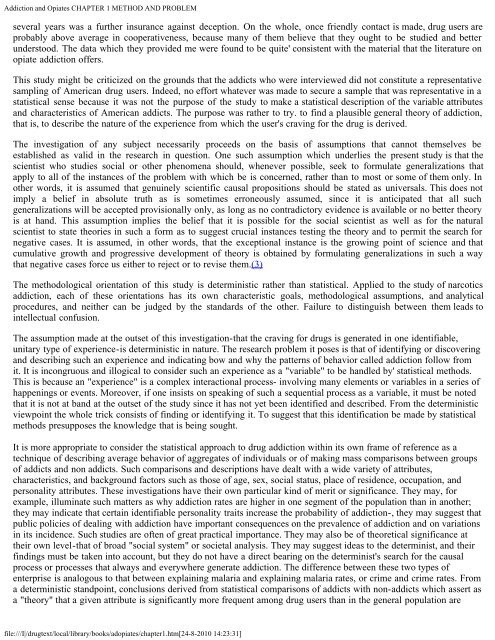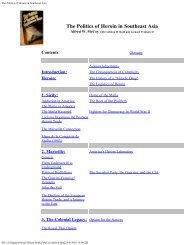Addiction and Opiates
Addiction and Opiates
Addiction and Opiates
Create successful ePaper yourself
Turn your PDF publications into a flip-book with our unique Google optimized e-Paper software.
<strong>Addiction</strong> <strong>and</strong> <strong>Opiates</strong> CHAPTER 1 METHOD AND PROBLEM<br />
several years was a further insurance against deception. On the whole, once friendly contact is made, drug users are<br />
probably above average in cooperativeness, because many of them believe that they ought to be studied <strong>and</strong> better<br />
understood. The data which they provided me were found to be quite' consistent with the material that the literature on<br />
opiate addiction offers.<br />
This study might be criticized on the grounds that the addicts who were interviewed did not constitute a representative<br />
sampling of American drug users. Indeed, no effort whatever was made to secure a sample that was representative in a<br />
statistical sense because it was not the purpose of the study to make a statistical description of the variable attributes<br />
<strong>and</strong> characteristics of American addicts. The purpose was rather to try. to find a plausible general theory of addiction,<br />
that is, to describe the nature of the experience from which the user's craving for the drug is derived.<br />
The investigation of any subject necessarily proceeds on the basis of assumptions that cannot themselves be<br />
established as valid in the research in question. One such assumption which underlies the present study is that the<br />
scientist who studies social or other phenomena should, whenever possible, seek to formulate generalizations that<br />
apply to all of the instances of the problem with which be is concerned, rather than to most or some of them only. In<br />
other words, it is assumed that genuinely scientific causal propositions should be stated as universals. This does not<br />
imply a belief in absolute truth as is sometimes erroneously assumed, since it is anticipated that all such<br />
generalizations will be accepted provisionally only, as long as no contradictory evidence is available or no better theory<br />
is at h<strong>and</strong>. This assumption implies the belief that it is possible for the social scientist as well as for the natural<br />
scientist to state theories in such a form as to suggest crucial instances testing the theory <strong>and</strong> to permit the search for<br />
negative cases. It is assumed, in other words, that the exceptional instance is the growing point of science <strong>and</strong> that<br />
cumulative growth <strong>and</strong> progressive development of theory is obtained by formulating generalizations in such a way<br />
that negative cases force us either to reject or to revise them.(3)<br />
The methodological orientation of this study is deterministic rather than statistical. Applied to the study of narcotics<br />
addiction, each of these orientations has its own characteristic goals, methodological assumptions, <strong>and</strong> analytical<br />
procedures, <strong>and</strong> neither can be judged by the st<strong>and</strong>ards of the other. Failure to distinguish between them leads to<br />
intellectual confusion.<br />
The assumption made at the outset of this investigation-that the craving for drugs is generated in one identifiable,<br />
unitary type of experience-is deterministic in nature. The research problem it poses is that of identifying or discovering<br />
<strong>and</strong> describing such an experience <strong>and</strong> indicating bow <strong>and</strong> why the patterns of behavior called addiction follow from<br />
it. It is incongruous <strong>and</strong> illogical to consider such an experience as a "variable" to be h<strong>and</strong>led by' statistical methods.<br />
This is because an "experience" is a complex interactional process- involving many elements or variables in a series of<br />
happenings or events. Moreover, if one insists on speaking of such a sequential process as a variable, it must be noted<br />
that it is not at b<strong>and</strong> at the outset of the study since it has not yet been identified <strong>and</strong> described. From the deterministic<br />
viewpoint the whole trick consists of finding or identifying it. To suggest that this identification be made by statistical<br />
methods presupposes the knowledge that is being sought.<br />
It is more appropriate to consider the statistical approach to drug addiction within its own frame of reference as a<br />
technique of describing average behavior of aggregates of individuals or of making mass comparisons between groups<br />
of addicts <strong>and</strong> non addicts. Such comparisons <strong>and</strong> descriptions have dealt with a wide variety of attributes,<br />
characteristics, <strong>and</strong> background factors such as those of age, sex, social status, place of residence, occupation, <strong>and</strong><br />
personality attributes. These investigations have their own particular kind of merit or significance. They may, for<br />
example, illuminate such matters as why addiction rates are higher in one segment of the population than in another;<br />
they may indicate that certain identifiable personality traits increase the probability of addiction-, they may suggest that<br />
public policies of dealing with addiction have important consequences on the prevalence of addiction <strong>and</strong> on variations<br />
in its incidence. Such studies are often of great practical importance. They may also be of theoretical significance at<br />
their own level-that of broad "social system" or societal analysis. They may suggest ideas to the determinist, <strong>and</strong> their<br />
findings must be taken into account, but they do not have a direct bearing on the determinist's search for the causal<br />
process or processes that always <strong>and</strong> everywhere generate addiction. The difference between these two types of<br />
enterprise is analogous to that between explaining malaria <strong>and</strong> explaining malaria rates, or crime <strong>and</strong> crime rates. From<br />
a deterministic st<strong>and</strong>point, conclusions derived from statistical comparisons of addicts with non-addicts which assert as<br />
a "theory" that a given attribute is significantly more frequent among drug users than in the general population are<br />
file:///I|/drugtext/local/library/books/adopiates/chapter1.htm[24-8-2010 14:23:31]





